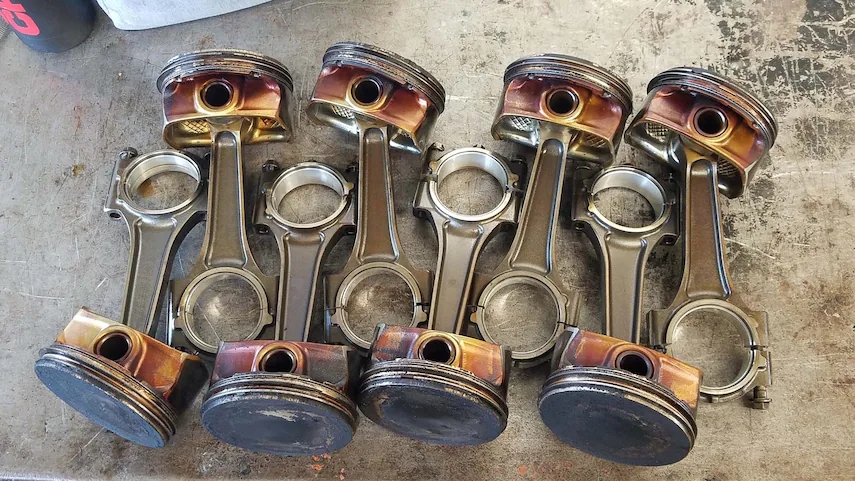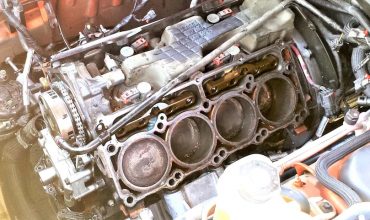Most people have heard of an engine rebuild but not as many really know what a rebuilt engine really is or what is done when an engine is rebuilt. Engines are rebuilt for a variety of reasons. In this article, we will take a look at why engines are rebuilt, what is done to rebuild an engine, and some signs that your car might benefit from a rebuild.
Reasons for a Rebuild
There are two main reasons people choose to rebuild an engine: wear to engine bearings, and poorly seating piston rings. The moving parts of the engine (such and the crankshaft, rods and pistons) are mounted on bearings that allow them to move freely. These bearings are lubricated by engine oil. Bearings are built to last many thousands of miles, but they do experience wear after time. This wear is accelerated exponentially when a vehicle is poorly maintained and is run on low oil levels or the oil change schedule isn’t properly followed.
Worn bearings produce loud knocking and eventually can cause a destructive failure of the engine. Piston rings seal in the expanding gasses created by the burning of gasoline within the engine. As Piston rings wear, they no longer seal the cylinders properly, resulting in a phenomenon called “blow-by.” Blow-by occurs when crankcase oil escapes past worn rings and is burned with the fuel mixture in the cylinder. Often this is the reason that older engines have an excessive amount of smoke in the exhaust.
What’s Done during an Engine Rebuild
When an engine is rebuilt, a few basic things are done to restore it to good working condition. First, the “short block” or lower half of the engine is removed and sent to an automotive machine shop. At the shop it is disassembled and cleaned so that the condition of the block can be properly assessed. Depending on the condition of the internal parts of the engine, the piston rings, bearings and sometimes the pistons themselves are replaced. The internal surfaces of the cylinders are also reconditioned to ensure that the new piston rings can form a proper seal with the cylinder walls. Finally, the engine is reassembled and installed back in the vehicle. Often the cylinder head is also reconditioned at the same time.

Signs You May Need a Rebuild
There are some frequently seen signs that a rebuild may be necessary for your engine. The most common sign is oil consumption and excessive white smoke in the exhaust, especially when the engine is cold. This is normally a sign of worn piston rings. More extreme signs could be metal shavings in the engine oil (a common sign of dangerously worn bearings) and “knocking” or “chattering” from the engine bearings.
Remember that a rebuild can be very expensive and it might not be the right choice for all vehicles. If you think that you might be in the market for a rebuild, you might also want to consider swapping in a lower-mileage engine or an engine that is in better condition as this option could be cheaper.
How to Evaluate Engine Rebuild Kits
Engine rebuild kits are a subject of some controversy in the automotive repair field. They are packaged and sold both by manufacturers, such as Sealed Power, and by individual parts wholesalers. The purpose of the kits is twofold. First, is to enable the buyer to obtain all needed parts at a reduced price. Second, is to force the buyer to obtain all needed parts from the same source. This means that all of the profit will go to the seller of the kit.
Engine rebuilders engaged in the working of an everyday passenger car love to buy engine rebuild kits, and will sometimes even keep a few in stock. The drawback to doing this is that the rebuilder is forced to tailor their rebuild to suit the parts in the kits. After engine removal, it may be found that crankshaft wear is negligible, but the rebuilder must still grind the crank to the size of the bearings included in the kit. If there is no hurry, the rebuilder can order a kit with whatever size bearings are needed. But most shops would rather not wait for a custom kit, and make do with what they have.
Once you have made the decision not to buy a new engine, disassemble the engine and measure everything. After the block and crank have been measured, decisions can be made about over or under-sized parts. Then the order can be placed for the kit. The seller of engine rebuild kits can then put together a kit with exactly what is needed for the rebuild. Given that thorough cleaning and machining of the old parts will take some time, the wait for a custom kit will not be an inconvenience. Probably the biggest advantage is the large discount given on pistons when they are ordered in a kit.
Before completion of the job, inventory the leftover parts to determine that you haven’t left anything out. While there are never any mechanical parts leftover from engine rebuild kits, there is frequently a pile of leftover gaskets that were included on a just-in-case basis. This is another reason that mechanics like the kits. They get a little drawer-full of “free” parts that may come in handy some day.

High Performance Kits
Engine rebuild kits intended for high-performance use are another story. These are usually ordered with the very largest pistons available. The selection of parts in one of these kits must be done on a custom basis. Choosing the parts and sizes needed to do a particular job in a performance engine is much more important than the same choices made for an ordinary passenger car. Nevertheless, buying engine rebuild kits is a great way to save money and ensure compatibility. Be sure to read the catalog and your micrometer carefully.

